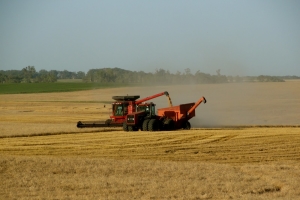For the first time since 2002, the new farm bill authorizes landowners to file updates on Farm Service Agency (FSA) yields on their  properties, using 90% of their 2008-2012 averages. They also have the chance to reallocate — but not increase — historic base acres to be more reflective of recent planting and production.
properties, using 90% of their 2008-2012 averages. They also have the chance to reallocate — but not increase — historic base acres to be more reflective of recent planting and production.
"The two choices are separate decisions, but this is a one-time option — so don't miss this important chance to impact your bottom line," advised Todd Jennison, an agribusiness consultant with Kennedy and Coe in Garden City, Kan. Whatever farm program choices you make will remain in effect through at least the 2014 to 2018 crops, so renters would be wise to help educate their landowners on the process.
On July 30, FSA issued new information and examples of the base reallocation decision in Notice ARCPLC-7 http://www.fsa.usda.gov/…. It also contained a sample letter to owners and producers that will be delivered in early August, giving 60 calendar days to notify the local FSA office of any changes that need to be made in their base records.
STUDY CONTINGENCY PLANS
The recent collapse in commodity prices should prod growers and owners to do their farm bill homework, farm lenders and advisers say. At current cash prices, high-yield Illinois farms could collect $45 to $77 per acre in county Agriculture Risk Coverage (ARC) payments for the 2014 crop, according to the University of Illinois. At the moment, economists don't expect corn to trigger a Price Loss Coverage (PLC) payment in 2014.
That's only a rough estimate, since above-average yields and higher-than-expected prices could reduce ARC payments somewhat. But Jennison said "the potential is a big one — and I'm using that word 'potential' more than I ever have" when trying to estimate farm program payments.
Jennison encourages clients to start early to gather planting information, since it could be time consuming and many landowners may not be aware of the farm program details. "You can get your actual yields and planted acres from your crop insurance company. Your current base and yield can be obtained from your local FSA office via the 156 EZ form," he said. "If you had yields that fell below 75% of the average of the 2008-2012 county yield, you can substitute a plug yield obtained from the FSA national webpage or from USDA's National Agricultural Statistics Service. They are based on the county yield averages estimated each year by USDA."
Signup for benefits under the Agriculture Act of 2014 won't start until at least late this year. You'll be asked to make a one-time choice to elect either PLC — a price-only program very similar to past Counter-Cyclical programs — or ARC that benchmarks revenue and pays when there is a shortfall. If landowners and renters can't agree on a program, the default choice will be PLC.
Payments for both programs are based on historical data — not current plantings — so the chance to update will give you a chance to capitalize on your operation's improved performance, Jennison emphasized.
Read Complete Article Here
Article by

